This plant with touching spread leaves, resembling a human palm, has recently, but already managed to win the hearts of flower growers in its culture with its decorativeness and unpretentiousness. Caring for a sheflera flower at home is simple, it is effortless even for beginner gardeners.
Material Content:
Species and varieties
The genus of sheffler, to which the flower belongs, is numerous and has up to 200 species. Not all are suitable for room culture, some can grow in natural conditions up to 40 m. At home, the height of the plant is much less, but some varieties reach the ceiling of the room. The flower easily tolerates pruning and shaping, here the fantasy of a gardener can be fully roamed. Most often in indoor culture, you can find the following species.
Scheffler's eight-leafed.
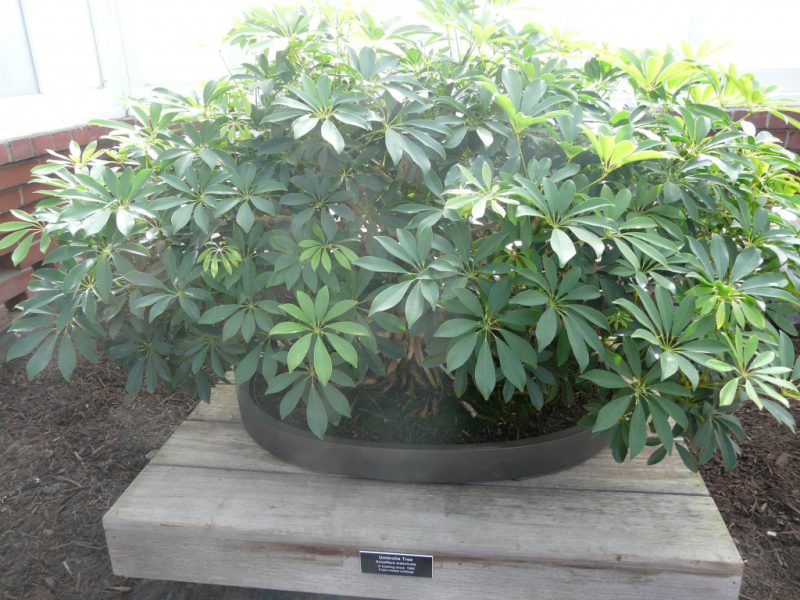
On creamy drooping petioles, from 8 to 12 large (up to 40 cm in length) glossy green leaves are located. Veins near the leaves have a lighter color. There are variegated forms. At home, in Asian countries, grows in the form of a bush or tree and reaches a height of 2 to 16 m.
Sheflera is tree-like.

Despite the name, it has a small height, although it grows in the form of a branchy tree. Leaves reach a length of up to 20 cm. Amate needs less light than other types, and it is very resistant to pests. The leaves are bright green, shiny.In the Gold Capella variety, the leaves are also green, but with small yellow spots. The plant itself is like a small palm tree. In Taiwan, where it grows wild, it is a four-meter evergreen bush. In room culture there are many miniature varieties with plain and variegated foliage: Melanie does not grow above 50 cm, Charlotte has beautiful white spots on leathery leaves, and the Caster variety is intended for lovers of small forms, 30 cm is the limit of its height. A tree shefler is successfully grown in the form of bonsai.
Sheflera radiant.

Sometimes it is called stellate. It is found in culture most often. Grows in the form of a tree with a gray-brown straight trunk. On brown-red long petioles, 7 ovate green shiny leaves with lighter veins and a wavy edge. The Nova variety is distinguished by its oak leaf shape. At home, in Australia, it is an epiphyte that grows on trees in rainforests and feeds through aerial roots. The room quickly grows to 80 cm, then grows slowly.
Shefler's most elegant.
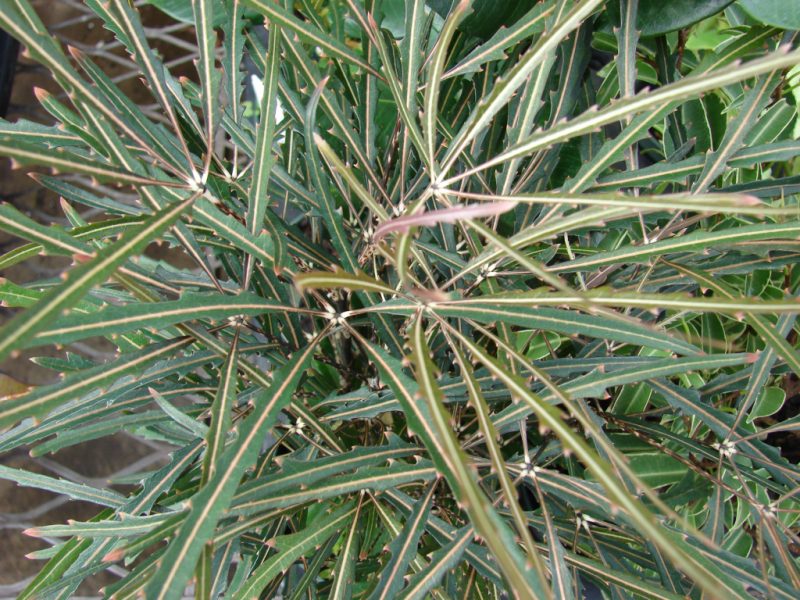
Even at home, in Australia and New Zealand, it reaches a height of only 2 m. The room does not grow above 50 cm. It has unusual elongated leaves with serrated edges, sometimes decorated with beige edging.
Shefler Veitch.
Young leaves of this species have a reddish tint. With age, they turn green. The leaves themselves are wavy, an edge with rounded denticles.
Shefler's business.
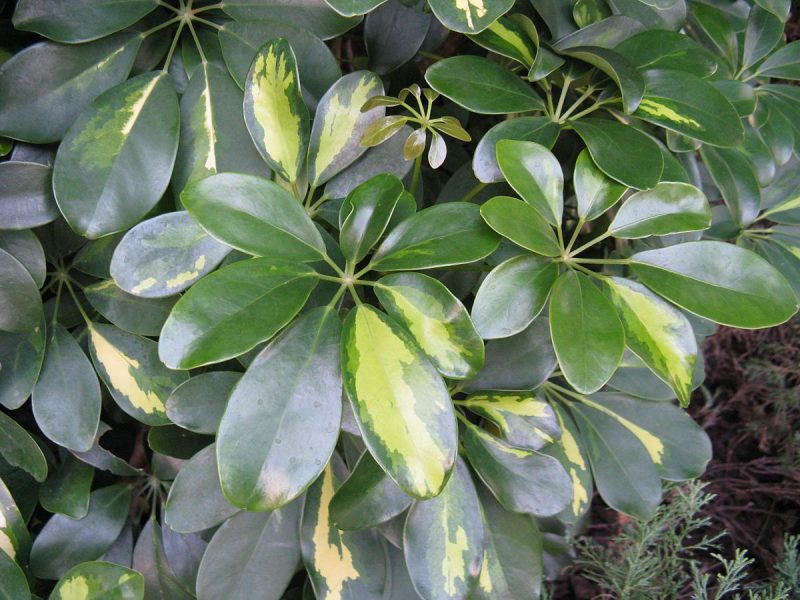
In the forests of Western China grows up to 3 m, in the room - only up to 50 cm. The leaf is unusual for a shefler, in shape resembles oak, but much larger in size. This species is less sensitive to light than others.
Shefler's flower - cultivation features

Scheffler is a plant of the tropics. It is difficult to create such conditions in the room, but the flower does not pretend to them. It is enough to simply observe the light and temperature conditions, protect it from drafts, properly water and feed. For variegated forms, good illumination is especially important, otherwise the plant may lose the brightness of the color of the leaves.
Home Care
The plant is unpretentious, but if you do not create the necessary conditions for it, it can just drop the leaves and lose all its decorativeness. As soon as care is adjusted, the shefler quickly builds up leaf mass.
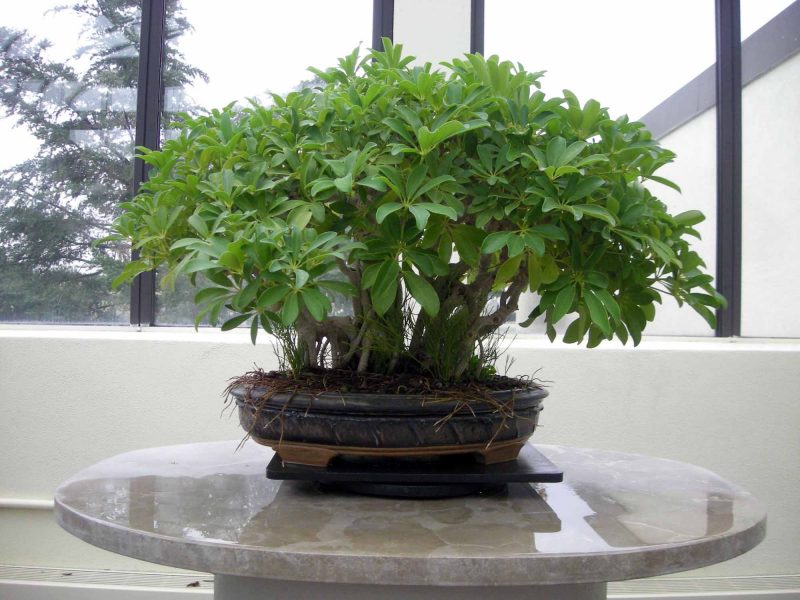
When working with a flower, you need to remember that the juice of the plant contains irritating mucous membranes and skin substances, so all manipulations associated with pruning must be done with gloves.
Lighting, temperature
This native of the tropics loves the light, but she only tolerates direct sunlight only at home. In the room, the midday sun can cause burns on the leaves. Therefore, the best windows are the share of sheflers - oriented to the southeast or southwest. Some species are able to feel good on the northern window, but only not variegated forms. They need more light - then the color of the leaves will be especially contrasted. In winter, the flower needs to provide maximum illumination, so it is better to rearrange it to the south window.

Turn the pot periodically so that the plant develops evenly.
The temperature regime for sheflera depends on the season. In winter, in a state of relative rest, she needs from 14 to 18 degrees of heat. For variegated forms, the temperature should be higher than for plants with completely green leaves. In summer, room temperature is suitable, but not higher than 30 degrees. Unlike many home plants, the shefler is not afraid of temperature fluctuations, on the contrary, they are beneficial to her, increasing the vitality of the flower. Therefore, boldly take it to the garden with the onset of heat, just pick up a place with a lace shadow in the afternoon.
Soil requirements
The plant loves the soil light and nutritious, well absorbing air and moisture. The soil reaction should be neutral or slightly acidic.

You can do with purchased soil intended for palm trees or make a soil mixture of the following composition:
- turf land - 2 parts;
- peat, sand, humus, sheet land - 1 part each.
Watering and humidity
Watering for this plant should be moderate. Overfilling is fraught with rotting of the root system, it should not be allowed. Water the flower when the topsoil dries out a little, in the summer - 2 or 3 times a week, in the winter - 1 time. Full drying of an earthen coma should not be allowed.

Scheffler loves high humidity. Raise it in the following ways:
- spraying the plants several times a day with soft and warm water;
- rubbing the leaves with a wet cloth;
- by placing the pot in a pan with moist expanded clay or moss, but so that moisture does not touch the drainage hole.
For any water treatment, only soft water with a minimum salt content is suitable. Its temperature should be slightly higher than that of the surrounding air.
Fertilizer and fertilizer
As soon as the first new leaf appears in spring, they begin to feed the shefler. This is done every 2 weeks with a complex fertilizer for ornamental plants, slightly reducing the dosage against the norm. Once a month, it is useful to spray the leaves with a solution of immunostimulants.
How to trim a shefler?
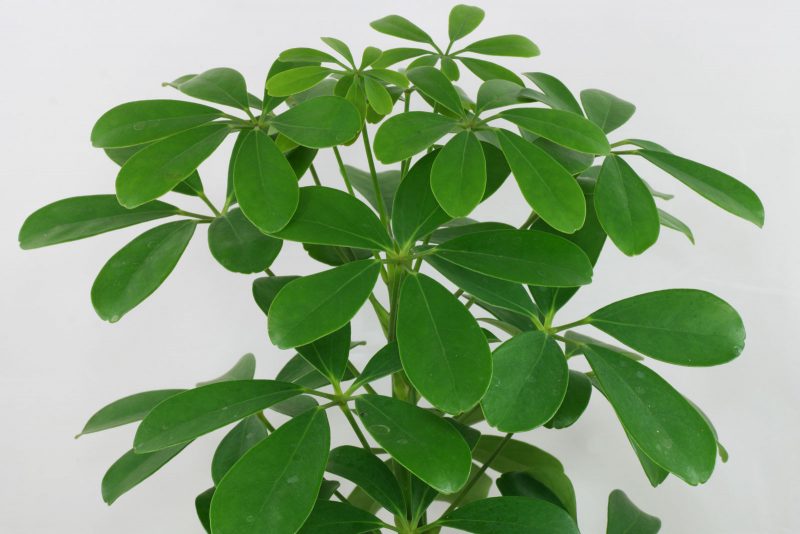
Cut the flower in order to form a lush crown and reduce the vertical dimensions of fast-growing varieties. The first pruning is carried out at a grown plant, shortening the apical shoot by 4 internodes. The trimmer must be sharp. Slices are best treated with crushed coal. After the appearance and growth of lateral shoots, you can begin to form a spherical crown, cutting off the tops of them. All cuttings can be used for propagation. Pruning weakens the plant, so do it in stages.
Transfer

Young sheflera requires an annual transplant, which is carried out in the spring. For an adult plant, this procedure is carried out every few years, choosing a pot larger than the previous one. The upper layer of the substrate in adult plants is changed annually. Shefler's flower needs good drainage - the volume of the drainage layer of expanded clay, fragments of an old pot or brick should occupy a quarter of the entire pot.
Feeding transplanted plants begins when they release a new leaf.
Rest period
It is very important for the plant. In low light conditions, he needs to slow down the metabolism.
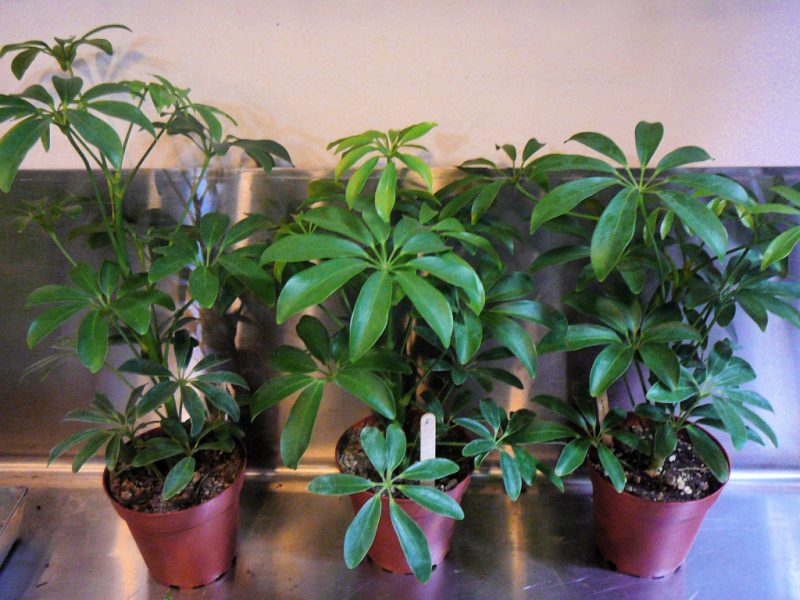
To do this, do the following:
- reduce feeding, it is enough to feed the shefler 2 times during the winter;
- reduce watering;
- lower temperature;
- Lighting during this period should be the maximum possible, this is especially important for variegated forms.
Sheffler flower propagation
Shefflers can be propagated by almost lignified cuttings, seeds and air layers.
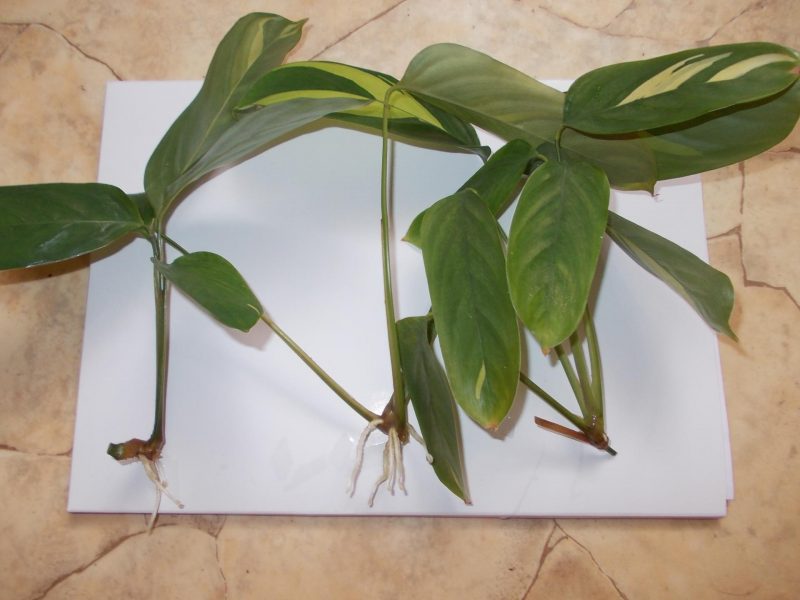
- Cuttings are cutled in the spring, making an oblique cut and leaving no more than three leaves on the handle, which are half cut. The slice should be dipped in a root formation stimulator and planted in a moist mixture of peat and sand under a plastic bag. In order for the stem to take root, the temperature of the soil should be about 25 degrees. The package is removed 1-2 times a day for ventilation, and the soil is moistened so as not to dry out. When the roots grow, young plants are planted in pots with a diameter of 9-10 cm.
Cuttings of variegated forms take root more difficult than green leaves.
- Sheflera seeds can be bought at the flower shop. Before sowing, they are soaked in an immunostimulant, for example, in Epin, and then sown in a mixture of peat and sand to a depth of about 2 cm and covered with a bag of polyethylene. Germination is possible at a temperature of about 25 degrees. Shefflers can be planted in separate cups when the second sheet appears. At first, young shefleurs need warmth.
- Air layers are obtained if sheflers are cut on the trunk and wrapped in moss moistened in a solution of root formation stimulant. Moss must be kept constantly wet. It is best to wrap it with polyethylene.As soon as the roots appear, and it happens after 2 months, cuttings are cut and planted in a permanent place. If you continue to care for the mother plant, wrapping the slice with wet moss, it will begin to branch.
Pests and possible plant diseases
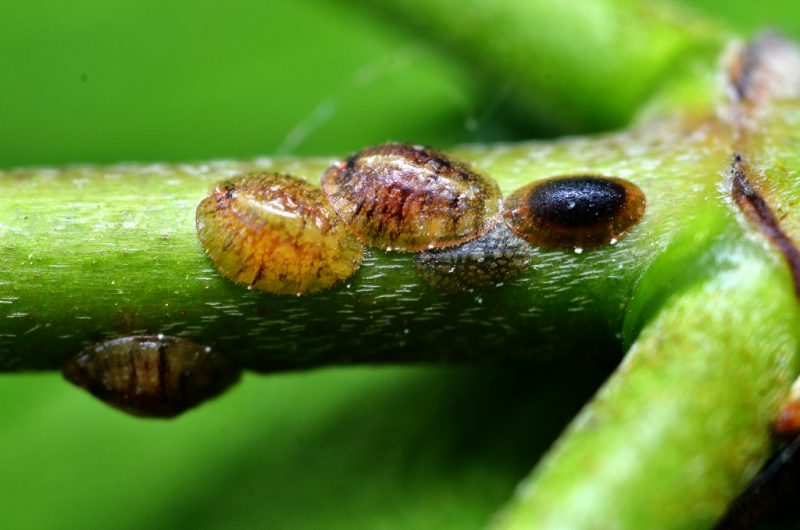
Sheflera pests are the same as other indoor plants:
- spider mite;
- scale insects;
- mealybug;
- aphid.
As a preventative measure, a warm shower with washing the leaves with a soap solution is suitable. The soil in the pot must be protected from getting wet. If these measures do not help, you will have to turn to the help of insecto-acaricides, which are approved for indoor use.
Scheffler turns yellow, drops leaves, turns black
The painful condition of the flower is usually caused by errors in care. The reasons for these phenomena may be different. In order for the plant to regain its decorativeness, care will have to be adjusted.
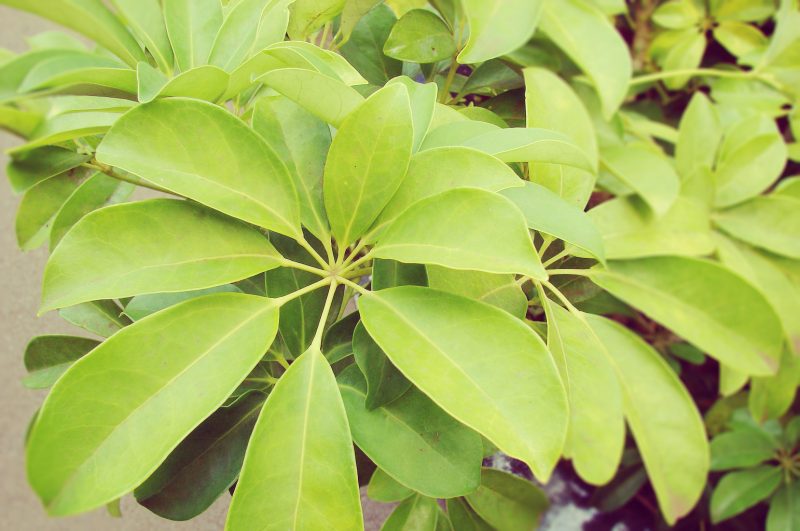
- The plant responds by dropping leaves to a too high temperature in the summer or too low in the winter. Another reason is excessive watering. The plant loses its leaves and if it lacks light.
- Yellow leaves can be a signal that pests have appeared on the flower. If they are not, then the flower is simply too hot.
- Sheflera leaves turn black if the root rots, which happens with excessive watering. The plant is removed from the pot, the damaged roots are trimmed and sprinkled with crushed coal, dried and planted again. Dark spots, starting from the tips, appear on the shefler with low humidity and lack of moisture in the pot.












